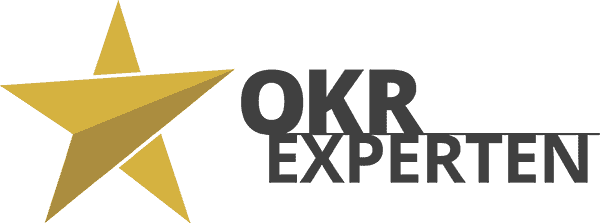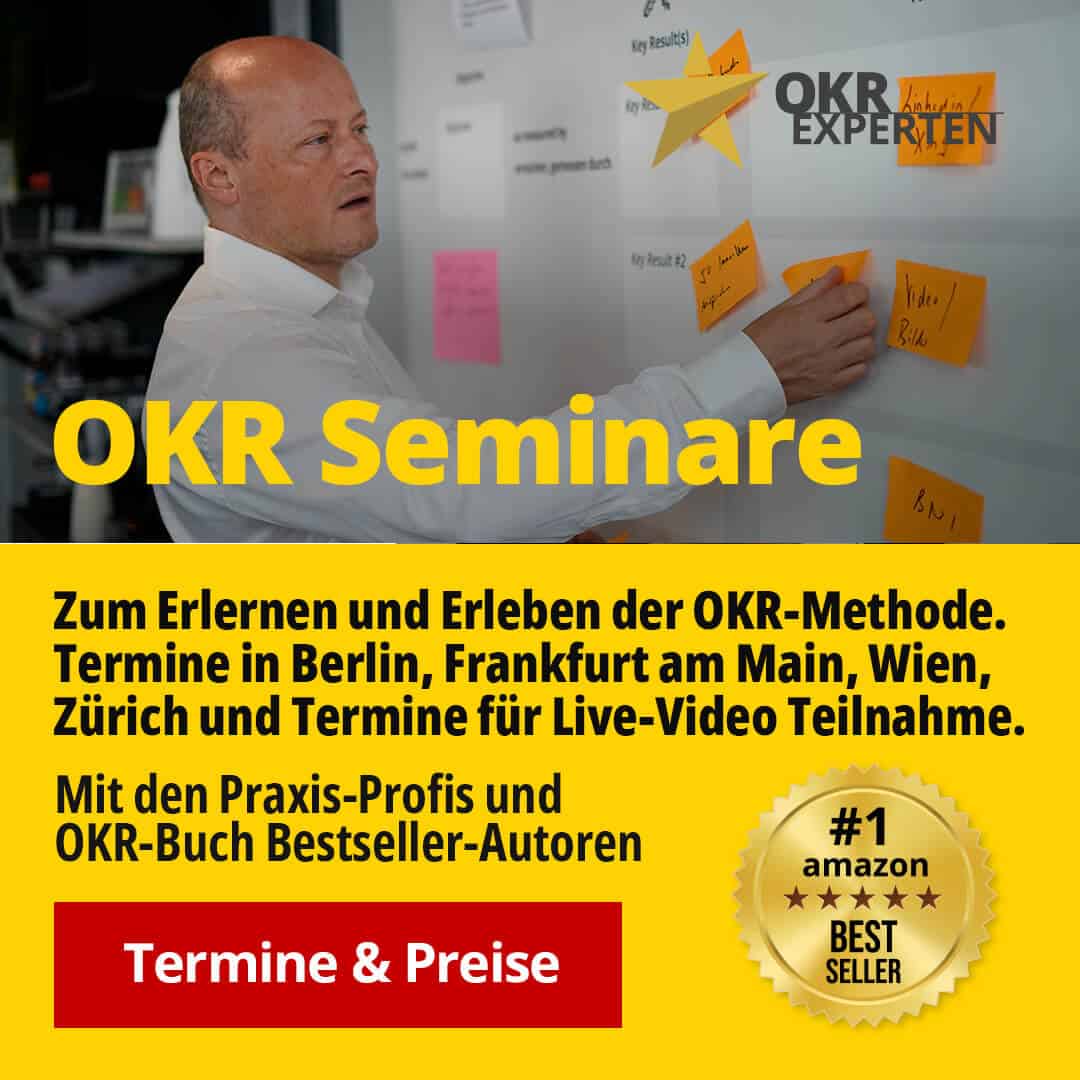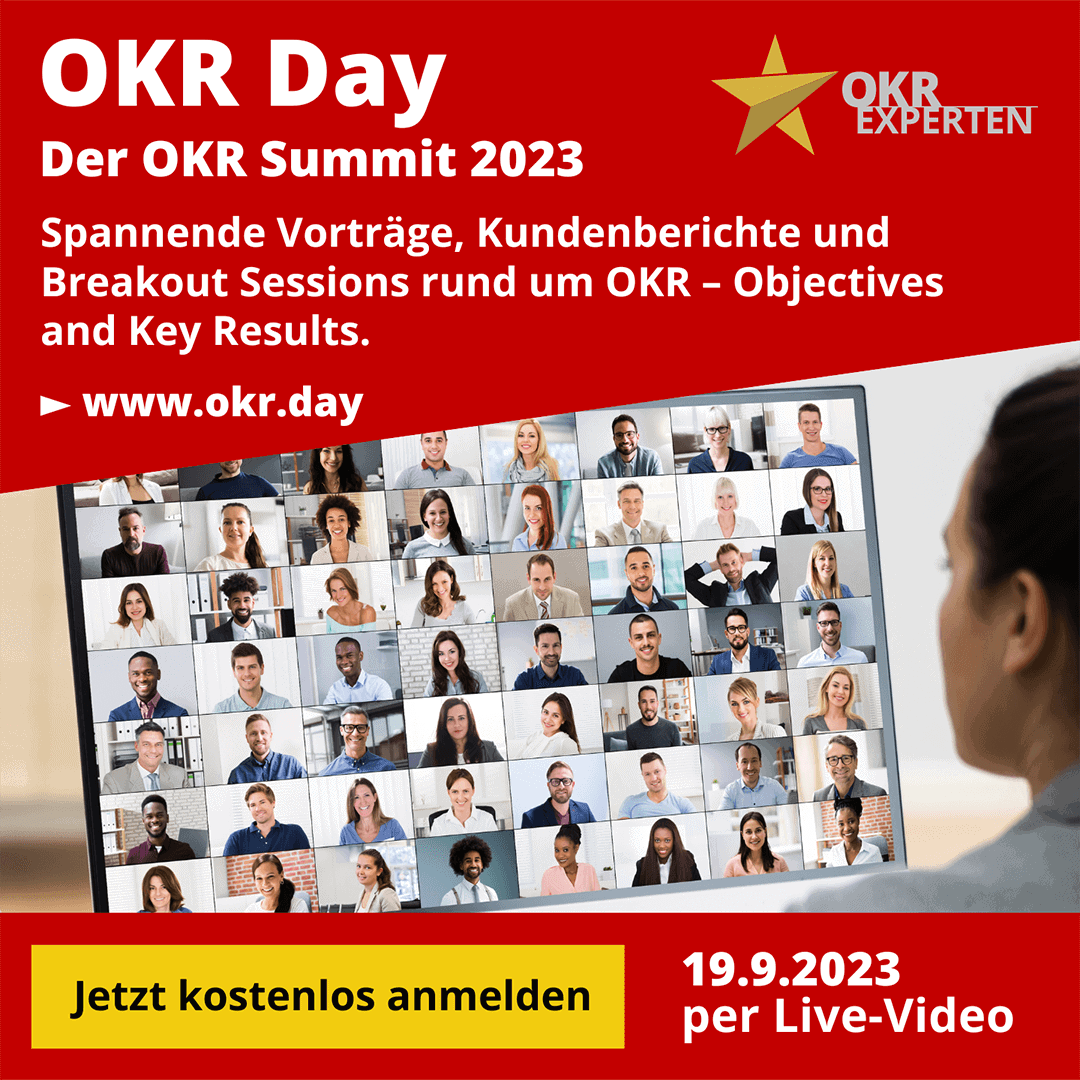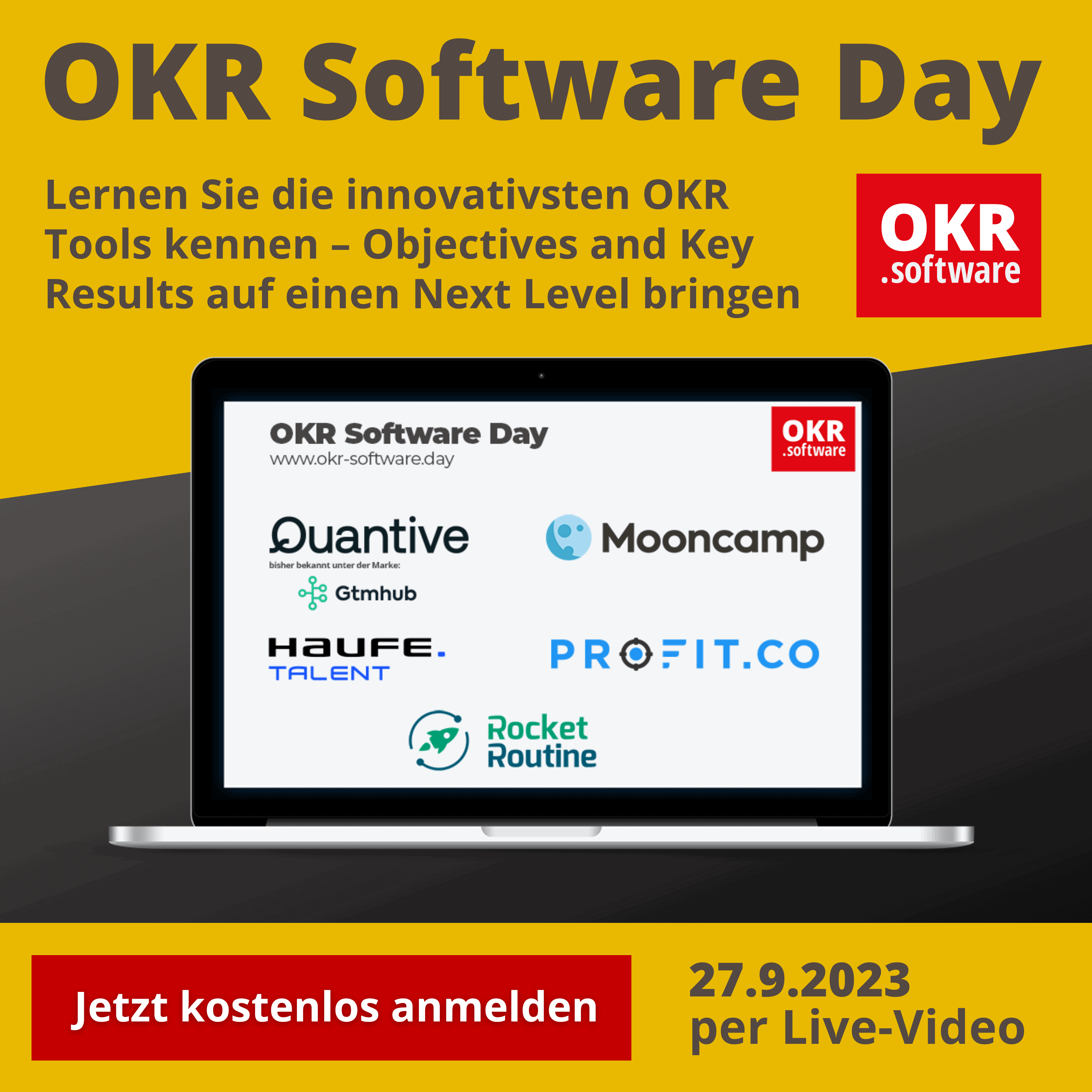OKR Definition – A compact introduction to the OKR method
In this article we have compiled the OKR definition and a compact introduction to the OKR method. This includes OKR values, OKR principles, OKR roles, OKR meetings, OKR artifacts, OKR tools and important OKR terms.
OKR is an acronym that stands for Objectives and Key Results.
If you are looking for an article that describes the definition of OKRs – examples of OKRs – then go to the article: OKR Examples.
What is OKR and the OKR method – different approaches to an OKR definition
The definition of OKR is not defined by any official organization.
Our definition of OKR is:
OKR (Objectives and Key Results) is an agile strategy execution method and modern goal-setting method. It helps to create focus, uniform alignment, coordination, commitment and transparency around ambitious, measurable goals.
The targets are normally set, tracked and reassessed on a quarterly basis. The OKR process also incorporates the perspective and creativity of each team. The aim is to ensure that everyone is moving in the same direction, with clear priorities, at a constant rhythm.
What does OKR help with?
- The company has not set any targets.
- It has no strategy or process model to achieve goals.
- Employees do not know which tasks contribute to achieving the objectives.
- They cannot measure success/failure and therefore cannot adjust strategies in good time.
- Employees are unmotivated because they do not see how their work contributes to the company’s success.
- The management level does not know what the employees / teams are working on at the moment.
- The company’s employees are not pulling in the same direction.
- There is a lack of communication and coordination between the teams.
Further approaches for an OKR definition
Wikipedia:
OKR is a management system for targeted and modern employee management. It is a framework for setting objectives and measuring key results.
(OKR definition – source: Wikipedia)
John Doerr:
OKR is a collaborative goal setting tool used by teams and individuals to set challenging, ambitious goals with measurable outcomes. OKRs allow you to track progress, create alignment and drive commitment to measurable goals.
(OKR definition – source: whatmatters.com)
Felip Castro, US-American OKR trainer:
OKR […] is a […] tool to create alignment and commitment around measurable goals.
(OKR definition – source: felipecastro.com)
OKR values: focus, alignment and coordination, commitment and transparency
The OKR values are very well described by the acronym FACTS. It stands for focus, alignment, commitment, transparency and stretch goals:
- Focus: OKR supports the implementation of a company’s vision, mission and strategy. OKR helps to bring focus into the company and increase effectiveness.
- Alignment (alignment/coordination): OKR also helps to ensure the alignment of managers, teams and employees.
- Commitment (obligation/commitment): OKR helps to demand and enter into commitment.
- Transparency: By publishing the OKR sets, OKR helps to implement and leverage transparency throughout the organization.
- Stretching / Stretch Goals: Through so-called “stretch goals” or moonshots, OKR helps you to take ambitious and creative paths and thus become even more successful.
We support you in the introduction of OKR, in OKR training and in optimizing the use of OKR in your company.
We support you in the introduction of OKR, in training and in optimizing the application in your company.
Erno Marius Obogeanu-Hempel and many other OKR Experts®
OKR principles
The OKR principles are not defined by any official organization.
Our idea of the OKR principles is:
- Vision: The company management, each department and each team pursues the long-term goal of implementing the corporate vision through its OKR sets in iterative cycles. The vision serves as the “North Star” and thus as a long-term point of orientation.
- Value orientation: The company management, each department and each team measures its results using the OKR sets in terms of the “outcome” achieved, i.e. the benefit and value contribution for the company – and therefore usually as a benefit and value contribution for its customers.
- Transparency: The OKR sets and their current actual key results metrics are freely accessible and visible to all managers and employees.
- Focus: A clear and consistent prioritization of the strategic initiatives and projects to be implemented to max. 3-5 objectives for each level and each team ensures a high level of focus.
- Ambitious: Higher goals lead to increased motivation and performance.
- 70% target achievement is good enough: John Doerr’s “70% are the new 100%” is well justified by the Pareto principle, because 80% of the results are achieved with 20% of the total effort. The remaining 20 % of the results require the most work in quantitative terms, accounting for 80 % of the total effort.
- Autonomy / Impact: The implementation of the tasks for fulfilling the OKR sets should be as autonomous, self-determined and self-organized as possible. Dependencies on other departments and teams should lead to optimal collaboration through “interlinked” OKR sets.
- Process fidelity: The OKR process is non-negotiable as it offers the teams reliability and security. It reduces overhead costs through a high degree of standardization and at the same time contributes to a high level of transparency. The OKR process can be adapted during implementation and transformation (e.g. in terms of timing).
- Feedback / CFR: All managers and employees take part in the OKR process. Everyone is involved and contributes to continuous improvement with their feedback. While OKR-Weeklys and OKR-Reviews provide feedback on content, the OKR-Retrospective provides methodological feedback. John Doerr speaks of CFR – Conversations, Feedback, Recognition – i.e. conversations, feedback and appreciation.
These OKR principles also contribute to a certain extent to the OKR definition.
How to define objectives and key results
Here’s an example from John Doerr of an OKR set to spend more time away from the office and with family:
- Objective: Spend more valuable time with the family.
- Key Result 1: Be home for dinner before 6 p.m. at least 20 evenings a month to have more quality time with the family.
- Key Result 2: We have increased quality time with the family on Sundays from 4 to 6 hours.
In our article OKR examples you will find many more examples for almost all departments of a company. You will also receive instructions on how to optimally define OKR in various departments.
Dos and don’ts when creating and defining OKRs
When defining and implementing OKR, a number of things need to be taken into account. Things you should do are at least as important as things you shouldn’t do. You will therefore find a table here to help you define OKR sets:
| Dos | Don'ts |
|---|---|
| Objectives und Key Results müssen innerhalb des Zyklus erreichbar ein | Objectives und Key Results setzen, die innerhalb des Zyklus unerreichbar sind und längern dauern – besser: in kleinere Ziele herunterbrechen. |
| Klare Kommunikation der OKR-Sets. Alle OKR-Sets werden veröffentlicht. Den Start macht die Management-Ebene mit den Top-Level / Unternehmens OKR-Sets. | Nur den Top-Down Ansatz verfolgen – besser: Top-down, bottom-up und horizontal |
| Ausrichtung, Abstimmung, Verantwortlichkeit und möglichst Autonomie | Key Results als Task formulieren – besser: messbare ergebnis-/wirkungsorientierte Metrik mit Zielwert. |
| 2 bis 4 OKR-Sets pro Ebene/Team und 2 bis 4 Key Results pro Objective | Zu viele Objectives setzen – besser: maximal 4 OKR-Sets pro Ebene/Team. |
The predecessor of OKR
Management by Objectives is the predecessor of OKR and was developed by Peter Drucker in the 1950s. The manager and employees agree on annual targets that are aligned with the company’s objectives.
Advantages of MbO:
- Clear goals for every employee
- Rewarding outstanding employees
Disadvantages of MbO:
- The team spirit is lost, as each employee is mainly pursuing their own personal goals
- Goals are usually obsolete after a short time
Later, Andy Grove, CEO of Intel at the time, improved Management by Objectives and developed Intel Management by Objectives (iMbO) – and defined OKR.
The history of OKR: How OKR was “invented”
Andy Grove introduced OKR at Intel, initially calling it iMbO (Intel Management by Objectives) and convinced his colleague John Doerr of the method, who later became investment manager for Google at venture capitalist Kleiner Perkins and introduced OKR there in 1999 – he became the most prominent evangelist of OKR after Andy Grove.
Larry Page from Google was so impressed by the model that he used it to manage Google. Larry Page attributes part of Google ‘s success to OKR.
Nowadays, many companies, including German ones, use OKR.
Structure of the OKR Framework
The OKR Framework is essentially based on the following key points:
OKR roles – responsibilities of the persons/groups involved:
- OKR Master, Coach: the person primarily responsible for the OKR process
- OKR set or key result owner: the main person responsible for an entire OKR set or an individual key result and who is accountable for it. He/she is responsible for publishing and updating the LRs.
- Top management, departments or teams: the group of employees who have committed to one or more OKR sets, are responsible for their progress and for taking measures and implementing them
OKR meetings and recurring activities – and recurring activities:
The OKR cycle is iterated over and over again. The OKR cycle comprises various meetings. It begins with the planning phase and the OKR planning meetings.
During the execution phase, work is carried out on the actual target fulfillment. Both Daily Huddles and OKR Weekly Meetings are held for voting purposes. At the end of the OKR cycle, the OKR reviews and OKR retrospectives take place in the final phase.
OKR vs. KPI
OKR (Objectives and Key Results) and KPIs (Key Performance Indicators) are both management tools for measuring and controlling performance and progress, but they have different focuses and applications.
OKR is used to define corporate, departmental or team objectives and to measure progress and their achievement. An “Objective” is a clearly defined goal, a mini-vision to be achieved, and the “Key Results” are specific, quantifiable results that measure the progress of this goal and indicate the achievement of this goal. The OKR model is designed to set ambitious goals and find innovative ways to achieve them. It encourages risk-taking and creativity, and it is flexible enough to adapt to changing circumstances.
KPI: KPI stands for Key Performance Indicator. These are specific, measurable metrics that are used to measure the performance and operational values of a company, department, team or system. KPIs are usually more focused on ongoing monitoring of performance and ensuring the consistency and quality of work performance and systems. They are used to monitor routine performance, operational activities and day-to-day business based on established standards and expectations.
In practice, many companies use both OKRs and KPIs, often in combination. OKRs can help to clarify strategic goals and priorities and focus on the important things, while KPIs can help to measure, monitor and track day-to-day performance – ensuring that the quality and consistency of work and systems is maintained.
Further information in the article: The OKR Method – Introduction to Objectives and Key Results






